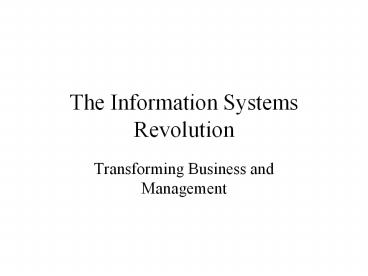The Information Systems Revolution PowerPoint PPT Presentation
1 / 39
Title: The Information Systems Revolution
1
The Information Systems Revolution
- Transforming Business and Management
2
Class Activity
- Break into groups of four and
- Introduce yourself to the members of your group
and describe yourself to the members of your
group - Information technology can help companies to
- Identify five knowledge- and information-intense
products
3
VW Mexico and the Internet
- SAPs ERP system integrated with the web to
reduce part ordering time from 10 to 5 days - Enabled dealer to use a browser and get order
information through an intranet on the worldwide
web
4
VW Mexico and the Internet
- SAPs ERP system integrated with the web to
reduce part ordering time from 10 to 5 days - Enabled dealer to use a browser and get order
information through an intranet on the worldwide
web
5
Information Systems
- Can help companies to
- Extend their reach to faraway locations
- Offer new products and services
- Reshape jobs and work flows, and perhaps
profoundly change the way they conduct business
6
Three Powerful Worldwide Changes
- Globalization
- Transformation of industrial economies to
knowledge and information-based economies - Transformation of the enterprise
7
Globalization
- Management Control In A Global Marketplace
- Competition In World Markets
- Global Work Groups
- Global Delivery Systems
1.5
8
Globalization
- Information systems are a powerful ally enabling
businesses to - Communicate with distributors, suppliers, and
customers worldwide - Operate 24/7
- Serve local and international reporting needs
- Compete globally by bringing your products and
services to a global market
9
Transformation of Industrial Economies
- To knowledge- and information-based service
economies. - Increase need for white-collar workers
- Manufacturing has moved to low-wage countries
- Knew knowledge- and information-intense products
10
Transformation of Industrial Economies
- To knowledge- and information-based service
economies. - Increase need for white-collar workers
- Manufacturing has moved to low-wage countries.
- Knew knowledge- and information-intense products
11
Transformation of Industrial Economies
- To knowledge- and information-based service
economies. - Increase need for white-collar workers
- Manufacturing has moved to low-wage countries.
For how long? - Knew knowledge- and information-intense products
12
LABOR FORCE COMPOSITION 1900-1996
1.9
13
Economic Transformation
- Knowledge-based Economies
- Productivity
- New Products Services
- Knowledge As An Asset
- Time-based Competition
- Shorter Product Life
- Turbulent Environment
- Limited Employee Knowledge Base
1.6
14
Knowledge- and Information-Intense Products
- Credit cards
- Overnight package delivery
- Worldwide reservation systems
15
Transformation Of The Enterprise
- Flattening
- Decentralization
- Flexibility
- Location Independence
- Low Transaction Costs
- Empowerment
- Collaborative Work
1.7
16
What is an Information System
- A set of interrelated components that
- Collects data - INPUT
- Transforms data - PROCESS
- Disseminates information - OUTPUT
17
SYSTEM
INPUT
OUTPUT
PROCESS
FEEDBACK
1.10
18
FUNCTIONS OF AN INFORMATION SYSTEM
1.11
19
What is an information system?
- An organizational and management solution, based
on information technology, to a challenge posed
by the environment.
20
INFORMATION SYSTEMS
ORGANIZATIONS
TECHNOLOGY
MANAGEMENT
21
The Key Elements of an Organization
- People
- Structure and operating procedures
- Politics
- Culture
22
People
- Knowledge workers
- Product or service designers and knowledge
creators - Data workers
- The paper-pushers
- Production or service workers
- Producers/service providers
23
Structure
- Sales and Marketing
- Manufacturing
- Finance
- Accounting
- Human Resources
24
SOCIOTECHNICAL PERSPECTIVE
- Information systems are sociotechnical systems.
Though they are composed of machines devices, and
hard physical technology, they require
substantial social, organizational, and
intellectual investment to make them work
properly
25
APPROACHES TO INFO SYSTEMS
TECHNICAL APPROACHES
COMPUTER SCIENCE
OPERATIONS RESEARCH
MANAGEMENT SCIENCE
BEHAVIORAL APPROACHES
26
Behavioral Approach
- Focuses on strategic business integration,
design, implementation, and utilization - Focuses on changes in
- Attitude
- Management and organizational policy
- Behavior
27
SYSTEM INTERDEPENDENCE
1.17
28
Information System Impacts
- What a business would like to do in five years is
often dependent on what its systems will be able
to do - Becoming the high-quality or low-cost producer
- Developing new products
- Increasing employee productivity
29
SCOPE OF INFO SYSTEMS
- 1950s TECHNICAL CHANGES
- 60s-70s MANAGERIAL CONTROL
- 80s-90s INSTITUTIONAL CORE ACTIVITIES
- GROWING IMPORTANCE
1.18
30
Computing Power
- Doubling every 18 months
- The performance of the microprocessors have
improved 25,000 times since their invention 25
years ago - Soaring power has spawned powerful communications
networks the largest of which is
31
What You Can Do On The Internet
- Communicate Collaborate
- Access Information
- Databases
- Discussions
- Chats
- Obtain Information
- FTP
- Entertainment
- Play, view, read, animate
- Business Transactions
- Advertise, sell, and purchase
1.19
32
The Number of Internet Users
- Greater than 250 million today!
33
New Options For Organizational Design
- Flattening Organizations
- Separating Work From Location
- Increasing Flexibility
- Refining Organizational Boundaries
- Reorganizing Work Flows
1.20
34
The Changing Management Process
- Enterprise Resource Planning
- Electronic Commerce
- Electronic Business
1.21
35
Enterprise Resource Planning
- Software Integrates All Facets
- Planning, Manufacturing, Inventory, Sales,
Finance, Accounting - Transactions Alert All Involved Factors
- Updates Files, Speeds Action, Cuts Cost
1.22
36
Electronic Commerce
- Internet Links Buyers, Sellers
- Lowers Transaction Costs
- Goods Services Advertised, Bought, Exchanged
Worldwide - B2B Transactions Increasing
1.23
37
Electronic Business
- Intranet Business Builds Private, Secure Network
- E-mail, Web Documents, Group Software Extends
Effective Communication Control - Virtual Organization
1.24
38
VIRTUAL ORGANIZATION
1.25
39
CHALLENGE OF INFO SYSTEMS
- STRATEGIC Maintaining a competitive edge
- GLOBALIZATIONIntegrated systems
- INFO ARCHITECTURE Development
- INVESTMENT What is the value?
- RESPONSIBILITY CONTROL Ethics
1.26

